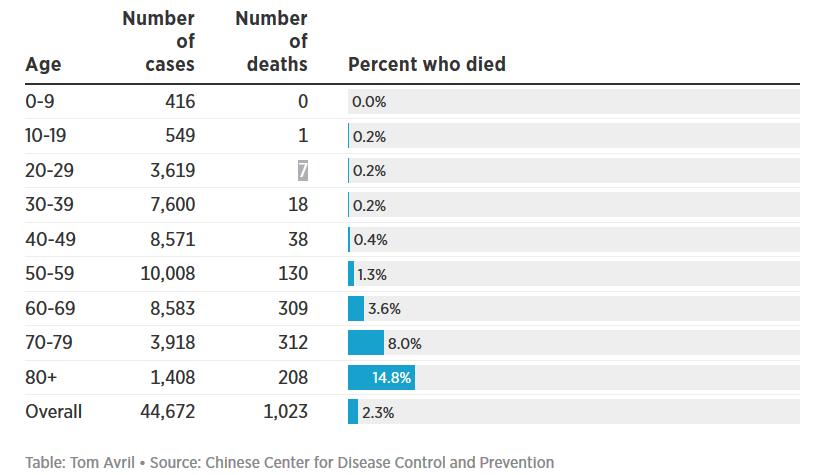Don't know this guy and of course I have no idea about how coronavirus will behave in Spring and Summer, but this is bullshit. These are common temperatures here in Italy and in February and March there are always a lot of cases of normal flu.
-
Ever wanted an RSS feed of all your favorite gaming news sites? Go check out our new Gaming Headlines feed! Read more about it here.
-
We have made minor adjustments to how the search bar works on ResetEra. You can read about the changes here.
You are using an out of date browser. It may not display this or other websites correctly.
You should upgrade or use an alternative browser.
You should upgrade or use an alternative browser.
This is probably the best site tracking active cases right now:I wish the statistics would focus more on active cases, which is what actually matters, over total cases (which basically just causes concern).

COVID Live - Coronavirus Statistics - Worldometer
Live statistics and coronavirus news tracking the number of confirmed cases, recovered patients, tests, and death toll due to the COVID-19 coronavirus from Wuhan, China. Coronavirus counter with new cases, deaths, and number of tests per 1 Million population. Historical data and info. Daily...
Former FDA Commissioner. Under Dump though so don't take what he says at full face value.Don't know this guy and of course I have no idea about how coronavirus will behave in Spring and Summer, but this is bullshit. These are common temperatures here in Italy and in February and March there are always a lot of cases of normal flu.
Thanks. And as shown in the chart, the active cases are steadily dropping (so more are recovering than contracting) - yet the total numbers continue to be what is focused on.This is probably the best site tracking active cases right now:

COVID Live - Coronavirus Statistics - Worldometer
Live statistics and coronavirus news tracking the number of confirmed cases, recovered patients, tests, and death toll due to the COVID-19 coronavirus from Wuhan, China. Coronavirus counter with new cases, deaths, and number of tests per 1 Million population. Historical data and info. Daily...www.worldometers.info
Nah, those are completely normal temperatures for February in Milan.
Not in Milan (Tuscany) but we had temperatures up to 20/22C° in the past few days, which is..quite a bit higher than normal
What is the difference between "total" and "active" cases?I wish the statistics would focus more on active cases, which is what actually matters, over total cases (which basically just causes concern).
Rising temps =/= above average temps.Don't know this guy and of course I have no idea about how coronavirus will behave in Spring and Summer, but this is bullshit. These are common temperatures here in Italy and in February and March there are always a lot of cases of normal flu.
Total is how many people have ever contracted it. Active are people currently infected with it. The media continuing to focus on the total number is silly.
Like in the US, 35 people HAVE HAD it. 35 people don't still have it. Only a portion of them do.
THe situation is much more serious than what some people think. Schools will be closed until 1 March in Emilia Romagna as well.Well, it's confirmed. People in Milan are in full blown panic.
My folks came from the supermarket, shelves are empty. Not even a box of pasta was anywhere to be seen.
Meanwhile the government will use 20 M euros which were originally destinated for stratch card prizes. Imagine being forced to do something like that... I wonder where Italy will be in 30-40 years.
Also key is the rate of new cases.Total is how many people have ever contracted it. Active are people currently infected with it. The media continuing to focus on the total number is silly.
Like in the US, 35 people HAVE HAD it. 35 people don't still have it. Only a portion of them do.
I suspect its gonna be like that in bergamo where I live, too. I'm scared s***less.Well, it's confirmed. People in Milan are in full blown panic.
My folks came from the supermarket, shelves are empty. Not even a box of pasta was anywhere to be seen.
This Onion timeline sure is something... "Italy runs out of pasta!"
It probably already is, you should check ASAP. Probably no use saying this, but I wouldn't panic if I were you.I suspect its gonna be like that in bergamo where I live, too. I'm scared s***less.
Ah, okay. I think that might be seen as under-reporting it though and can give a false sense of things being better than they truly are. Also, didn't they say it was possible to get reinfected?Total is how many people have ever contracted it. Active are people currently infected with it. The media continuing to focus on the total number is silly.
Like in the US, 35 people HAVE HAD it. 35 people don't still have it. Only a portion of them do.
I can't believe we jumped to rank 3 world in 2 days, all because of those fucking people from lodi? I'm so sure that those people that went in the streets like nothing happened are infected by now.It probably already is, you should check ASAP. Probably no use saying this, but I wouldn't panic if I were you.
I don't know what to do, I think I only have 2weeks of food at home and Im scared of going out now.
Honest question. How is being worried about something like that fear-mongering?
There is concern, and then there is 'this is the end of the world and I'm signing my death warrant'
Three more cases in Trentino Alto Adige (they came from Lombardy too). Jesus Christ, this isn't ending soon.


In Trentino tre turisti lombardi positivi al coronavirus
Tre persone originarie della Lombardia sono risultate positive al
www.agi.it
Italy :(
My reason is partially selfish (parents' trip in May will likely have to be postponed as my mom would be considered vulnerable), but man, I hope you guys can get a hold on it. I love Italy. It's so beautiful there, and the people are lovely, so please be okay, stay safe.
Every country though. South Korea, Japan, Iran, Hong Kong, China, and everywhere else, you are all beautiful, you're all fighters, everyone stay safe. 🙏
Also, Nymir your situation sounds rough, you're in my thoughts. I hope things go okay :(
My reason is partially selfish (parents' trip in May will likely have to be postponed as my mom would be considered vulnerable), but man, I hope you guys can get a hold on it. I love Italy. It's so beautiful there, and the people are lovely, so please be okay, stay safe.
Every country though. South Korea, Japan, Iran, Hong Kong, China, and everywhere else, you are all beautiful, you're all fighters, everyone stay safe. 🙏
Also, Nymir your situation sounds rough, you're in my thoughts. I hope things go okay :(
Found some pics on Reddit:Well, it's confirmed. People in Milan are in full blown panic.
My folks came from the supermarket, shelves are empty. Not even a box of pasta was anywhere to be seen.
This Onion timeline sure is something... "Italy runs out of pasta!"




Full gallery https://imgur.com/gallery/KthGJJj
In Italy the numbers will go up a lot in the next week, but it's not surprising. All cases are still linked to the same cluster and they were contracted before we even knew the virus was within our borders. I'm still confident that the rates of active cases will star to go down in the long run thanks to the very strong measures the government is taking. Also, people are scared as fuck, noone wants to go out even in areas that have nothing to do with the virus.
Yup, same in my local Esselunga and that place is really fucking big.
Yeah I think I'll buy a little extra food next grocery trip even though I'm in the US. Shit I would buy anyway. We'll go through it whether or not the virus comes here.
No. The supposed patient zero never even had it.
It's probably good to keep both in mind, and then some. The active cases number going down due to the lockdown in China may mask the upswing in countries like South Korea, Italy, and Iran where the virus isn't fully mapped out or under control yet. The media's always going to report on the total number since it's bigger and will always go up. No one number will tell the full story.Thanks. And as shown in the chart, the active cases are steadily dropping (so more are recovering than contracting) - yet the total numbers continue to be what is focused on.
Now, as i have heard this argument repeated in here numerous times, i would really like someone maybe a bit more knowledgeable than myself to chime in here. The argument that we should not worry too much if we are not 1) elderly or 2) have pre-existing conditions (whereas this a huge gray area to me since you'd have to define exactly what counts as a pre-existing condition and what not), does this argument REALLY hold strong?
I mean, and i'd love someone to correct me if i am wrong here, but as far as I know, 1 in 5 people (roughly 20%) develops a "severe" form of this virus correct? And this pretty much includes anyone right? Or do ONLY people with said pre-existing conditions / elderly make up these 20%? Note how i am not talking about mortality rate here but of the rate of the people that catch a severe course of the disease
Now, say it's the former. That would mean that you'd indeed likely be fine if you are either NOT elderly or have pre-existing conditions but ONLY in the event that you would get to a hospital in time with your severe pneumonia so you can be treated, because i am pretty sure even a young, healthy person may not survive viral pneumonia at home right? So in the event of an epidemic, when you can no longer GET a bed in hospital, then that would indeed put a young, previously healthy individual in a life or death situation correct?
It's all in the way the stats are meant to be understood, i'd really appreciate some insight into this factor since i cannot seem to find clarification anywhere really...
I mean, and i'd love someone to correct me if i am wrong here, but as far as I know, 1 in 5 people (roughly 20%) develops a "severe" form of this virus correct? And this pretty much includes anyone right? Or do ONLY people with said pre-existing conditions / elderly make up these 20%? Note how i am not talking about mortality rate here but of the rate of the people that catch a severe course of the disease
Now, say it's the former. That would mean that you'd indeed likely be fine if you are either NOT elderly or have pre-existing conditions but ONLY in the event that you would get to a hospital in time with your severe pneumonia so you can be treated, because i am pretty sure even a young, healthy person may not survive viral pneumonia at home right? So in the event of an epidemic, when you can no longer GET a bed in hospital, then that would indeed put a young, previously healthy individual in a life or death situation correct?
It's all in the way the stats are meant to be understood, i'd really appreciate some insight into this factor since i cannot seem to find clarification anywhere really...
Now, as i have heard this argument repeated in here numerous times, i would really like someone maybe a bit more knowledgeable than myself to chime in here. The argument that we should not worry too much if we are not 1) elderly or 2) have pre-existing conditions (whereas this a huge gray area to me since you'd have to define exactly what counts as a pre-existing condition and what not), does this argument REALLY hold strong?
Even if you're young and healthy, you could be a silent carrier for the virus, spreading it to the most vulnerable (the elderly or people with pre-existing conditions). It's important to take appropriate measures not just for our own safety, but for the safety of everyone else.
Even if you're young and healthy, you could be a silent carrier for the virus, spreading it to the most vulnerable (the elderly or people with pre-existing conditions). It's important to take appropriate measure not just for our own safety, but for the safety of everyone else.
I totally agree, but still, i am wondering how the data needs to be understood and if i am reading this correctly, because in one scenario we are talking about a whole other demographic that is ADDED to the already vulnerable one and this would of course overwhelm any healthcare system in the world.
Now, as i have heard this argument repeated in here numerous times, i would really like someone maybe a bit more knowledgeable than myself to chime in here. The argument that we should not worry too much if we are not 1) elderly or 2) have pre-existing conditions (whereas this a huge gray area to me since you'd have to define exactly what counts as a pre-existing condition and what not), does this argument REALLY hold strong?
I mean, and i'd love someone to correct me if i am wrong here, but as far as I know, 1 in 5 people (roughly 20%) develops a "severe" form of this virus correct? And this pretty much includes anyone right? Or do ONLY people with said pre-existing conditions / elderly make up these 20%? Note how i am not talking about mortality rate here but of the rate of the people that catch a severe course of the disease
Now, say it's the former. That would mean that you'd indeed likely be fine if you are either NOT elderly or have pre-existing conditions but ONLY in the event that you would get to a hospital in time with your severe pneumonia so you can be treated, because i am pretty sure even a young, healthy person may not survive viral pneumonia at home right? So in the event of an epidemic, when you can no longer GET a bed in hospital, then that would indeed put a young, previously healthy individual in a life or death situation correct?
It's all in the way the stats are meant to be understood, i'd really appreciate some insight into this factor since i cannot seem to find clarification anywhere really...
I think this earlier post gives about as good of a picture as we currently have, at least when it comes to fatalities:
According this table posted in an earlier article, one person in the 10-19 age range has died in China and 7 (now 8 with Xia Sisi's death) in the 20-29 age range.

The vast majority of the deaths here (829 of 1,023) are from people over 60. I don't think we have stats on what it looks like split out by pre-existing conditions. Anecdotally, it sounds like some of the younger deaths are from people in extremely stressful / high-workload situations (such as the doctors trying to treat everyone).
(Edit: Running the numbers a bit more. The 60+ crowd represents 81% of the deaths but only 31% of the cases.)
This is why it is not an overreaction to put together as robust of an emergency kit/food and water supply as you can manage.
Train stopped with two suspected coronavirus cases at the Austrian border

 m.oe24.at
m.oe24.at

Innenministerium gibt Entwarnung – Kein Coronavirus
oe24-EXKLUSIV: An der Brenner-Grenze wurde laut Sicherheitskreisen ein Zug mit zwei Coronavirus-Verdachtsfällen an Bord gestoppt – Kurz darauf wurde der Zugverkehr zwischen Österreich und Italien eingestellt.
As AUSTRIA just learned from security circles, a train coming from Italy was stopped at the Brenner border. There were two people on board with a fever who were suspected of being infected with the corona virus. The State Medical Directorate confirmed to oe24 that there was a "corresponding incident".
We are well prepared in Austria, "said Interior Minister Karl Nehammer (ÖVP) earlier at a media meeting at the Interior Ministry on Sunday morning regarding the spread of the new corona virus in Italy with three deaths." There is no need to panic. "You are with the Italian authorities in close coordination. "We are fortunate that there is no case in Austria."
You're presenting a false choice Winnie. The 20% rate is based on total number of cases so without digging into the stats you won't be able to say definitively what the risk factor is for a severe case based on age, however if you are young and healthy it's more likely that you will be in the 80% of milder cases.
You're presenting a false choice Winnie. The 20% rate is based on total number of cases so without digging into the stats you won't be able to say definitively what the risk factor is for a severe case based on age, however if you are young and healthy it's more likely that you will be in the 80% of milder cases.
This is exactly what i am wondering. So i guess it's not as clear cut as i thought and there really is no simple, definite answer here yet until we learn more about the cases and get some new stats i suppose.
If you go to page 21 of this https://www.medrxiv.org/content/10.1101/2020.02.06.20020974v1.full.pdf+html . It breaks cases down by age range and severe/non-severe for 1099 patients. Also has some info on pre-existing conditions.Now, as i have heard this argument repeated in here numerous times, i would really like someone maybe a bit more knowledgeable than myself to chime in here. The argument that we should not worry too much if we are not 1) elderly or 2) have pre-existing conditions (whereas this a huge gray area to me since you'd have to define exactly what counts as a pre-existing condition and what not), does this argument REALLY hold strong?
I mean, and i'd love someone to correct me if i am wrong here, but as far as I know, 1 in 5 people (roughly 20%) develops a "severe" form of this virus correct? And this pretty much includes anyone right? Or do ONLY people with said pre-existing conditions / elderly make up these 20%? Note how i am not talking about mortality rate here but of the rate of the people that catch a severe course of the disease
Now, say it's the former. That would mean that you'd indeed likely be fine if you are either NOT elderly or have pre-existing conditions but ONLY in the event that you would get to a hospital in time with your severe pneumonia so you can be treated, because i am pretty sure even a young, healthy person may not survive viral pneumonia at home right? So in the event of an epidemic, when you can no longer GET a bed in hospital, then that would indeed put a young, previously healthy individual in a life or death situation correct?
It's all in the way the stats are meant to be understood, i'd really appreciate some insight into this factor since i cannot seem to find clarification anywhere really...
It shows age greatly affects severity chance. ~28% chance of severe case if over 65 vs ~12% if 15-49.
If you go to page 21 of this https://www.medrxiv.org/content/10.1101/2020.02.06.20020974v1.full.pdf+html . It breaks case down by age range and severe/non-severe for 1099 patients. Also has some info on pre-existing conditions.
It shows age greatly affects severity chance. ~28% chance of severe case if over 65 vs ~12% if 15-49.
Thanks! Hmmm... I wouldn't say "greatly" but there is a difference yes. I mean, this still means a random healthy 16 year old has a 12% chance to get a severe course out of the blue if he gets infected (and hopefully get a bed in a non overcrowded hospital) which is still pretty horrible. I will have to look into it more in detail to be sure though.
Stuff like what you're asking for will take longer to determine. The virus has only been around since december, and the scientific community probably started studying it in January after the cases blew up. A month for stuff like this is nothing.This is exactly what i am wondering. So i guess it's not as clear cut as i thought and there really is no simple, definite answer here yet until we learn more about the cases and get some new stats i suppose.
This a developing situation and statistics could maintain a similar trend or change course. Plus, there tons of other factors to consider, like a country's health infrastructure and how prepared they are to deal with a potential outbreak.
Better to wait a bit more on that data.
Stuff like what you're asking for will take longer to determine. The virus has only been around since december, and the scientific community probably started studying it in January after the cases blew up. A month for stuff like this is nothing.
This a developing situation and statistics could maintain a similar trend or change course. Plus, there tons of other factors to consider, like a country's health infrastructure and how prepared they are to deal with a potential outbreak.
Better to wait a bit more on that data.
I agree.. probably better to try and be patient in general i suppose. The factor that scares me most is easily the fact that the healthcare infrastructure can probably not cope with the number of patients and people that would otherwise easily have survived a severe course of this (because they could be treated in a hospital bed) would potentially die.
That makes more sense than what I was getting by simply projecting out ~9 serious cases per death (following the ration of 20% serious cases : 2.3% deaths; the math breaks down for older age groups as it predicts more serious cases than exist). A takeaway there would be that the outcome for a severe case is also partially dependent on age; younger patients generally fare better even if they contract a serious case, if I'm understanding this right, and conversely this gets very scary for older patients (not that it wasn't already).If you go to page 21 of this https://www.medrxiv.org/content/10.1101/2020.02.06.20020974v1.full.pdf+html . It breaks cases down by age range and severe/non-severe for 1099 patients. Also has some info on pre-existing conditions.
It shows age greatly affects severity chance. ~28% chance of severe case if over 65 vs ~12% if 15-49.
edit: I should add: I'm not a doctor, just a guy who works with numbers a lot. I'm likely missing a lot of things here and the above shouldn't be taken that seriously.
I agree.. probably better to try and be patient in general i suppose. The factor that scares me most is easily the fact that the healthcare infrastructure can probably not cope with the number of patients and people that would otherwise easily have survived a severe course of this (because they could be treated in a hospital bed) would potentially die.
It's better to not speculate on this stuff becuse there are others who check the thread for info, and all this may cause unneded bouts of anxiety for them.
Wuhan's situation is unique and hasn't repeated anywhere, so the factor you mention about infraestructure hasn't been relevant outside of the Hubei region(although it cannot be discarded). Other countries have not faced infraestructure crisis, even other regions in China haven't seen that.
It's better to not speculate on this stuff becuse there are others who check the thread for info, and all this may cause unneded bouts of anxiety for them.
Wuhan's situation is unique and hasn't repeated anywhere, so the factor you mention about infraestructure hasn't been relevant outside of the Hubei region(although it cannot be discarded). Other countries have not faced infraestructure crisis, even other regions in China haven't seen that.
You are probably right... i'm off to meditate a little to take my mind of things now ;)
Disclaimer: This article dates back to February 12th, 2020.
Potential role of inanimate surfaces for the spread of coronaviruses and their inactivation with disinfectant agents

 www.sciencedirect.com
www.sciencedirect.com
Potential role of inanimate surfaces for the spread of coronaviruses and their inactivation with disinfectant agents

Potential role of inanimate surfaces for the spread of coronaviruses and their inactivation with disinfectant agents
The novel human coronavirus SARS-CoV-2 has become a global health concern causing severe respiratory tract infections in humans. Human-to-human transm…
 www.sciencedirect.com
www.sciencedirect.com
In a recent review on the persistence of human and veterinary coronaviruses on inanimate surfaces it was shown that human coronaviruses such as Severe Acute Respiratory Syndrome (SARS) coronavirus, Middle East Respiratory Syndrome (MERS) coronavirus or endemic human coronaviruses (HCoV) can persist on inanimate surfaces like metal, glass or plastic for up to 9 days. Some disinfectant agents effectively reduce coronavirus infectivity within 1 minute such 62%–71% ethanol, 0.5% hydrogen peroxide or 0.1% sodium hypochlorite. Other compounds such as 0.05%–0.2% benzalkonium chloride or 0.02% chlorhexidine digluconate are less effective. An effective surface disinfection may help to ensure an early containment and prevention of further viral spread.
Contamination of frequent touch surfaces in healthcare settings are a potential source of viral transmission. Data on the transmissibility of coronaviruses from contaminated surfaces to hands were not found. However, it could be shown with influenza A virus that a 5 s contact is sufficient to transfer 31.6% of the viral load to the hands [9]. The transfer efficiency was lower with parainfluenza-virus 3 (1.5%) [10]. Although the viral load of coronaviruses on inanimate surfaces is not known during an outbreak situation it seems plausible to reduce the viral load on surfaces by disinfection, especially on frequent touch surfaces in the immediate patient surrounding where the highest viral load can be expected.
We've known this already, but the CDC just made a public announcement (~1 & 1/2 hours ago) on their Twitter account:
80% of cases are mild, only 2% of cases result in critical conditions and that's almost always the very old or infirm.like i feel like this is the end, and it sucks because i have to travel next month, i cant back out of it because of familial obligations and i feel like i signed my own death warrant
Don't worry and stay out of this thread
This is a very descriptive article that somewhat summarises things.

 www.bbc.com
www.bbc.com

Coronavirus: Tracking the global outbreak
Key maps and charts explaining how the respiratory virus has spread around the world and how it is being dealt with.

